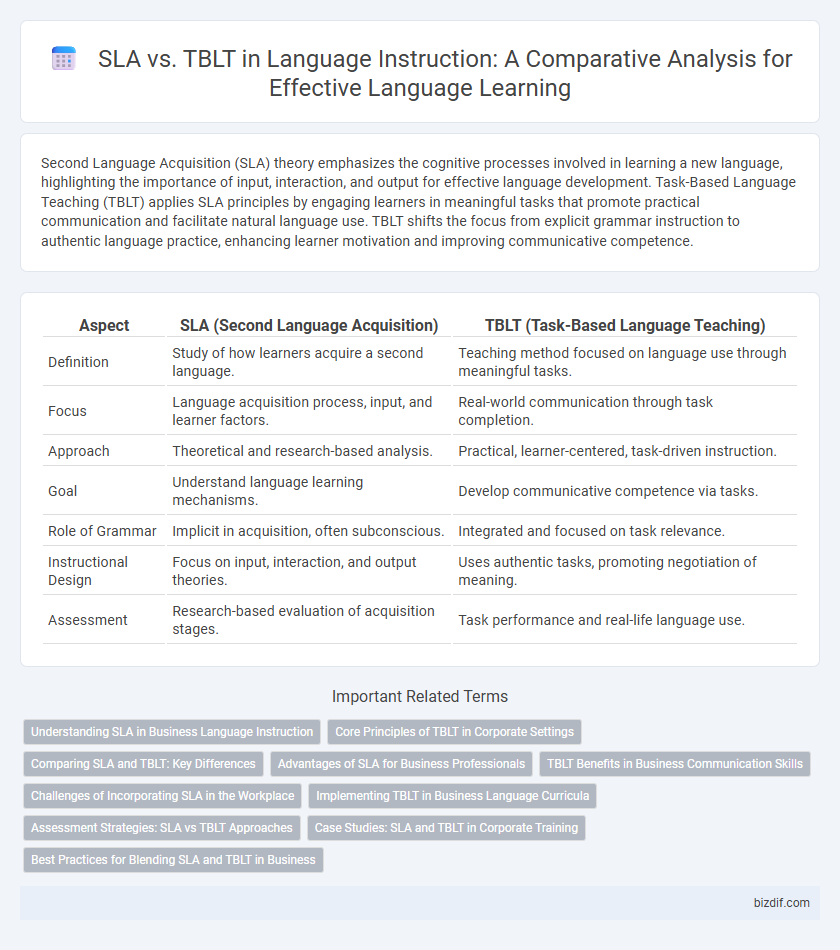Second Language Acquisition (SLA) theory emphasizes the cognitive processes involved in learning a new language, highlighting the importance of input, interaction, and output for effective language development. Task-Based Language Teaching (TBLT) applies SLA principles by engaging learners in meaningful tasks that promote practical communication and facilitate natural language use. TBLT shifts the focus from explicit grammar instruction to authentic language practice, enhancing learner motivation and improving communicative competence.
Table of Comparison
| Aspect | SLA (Second Language Acquisition) | TBLT (Task-Based Language Teaching) |
|---|---|---|
| Definition | Study of how learners acquire a second language. | Teaching method focused on language use through meaningful tasks. |
| Focus | Language acquisition process, input, and learner factors. | Real-world communication through task completion. |
| Approach | Theoretical and research-based analysis. | Practical, learner-centered, task-driven instruction. |
| Goal | Understand language learning mechanisms. | Develop communicative competence via tasks. |
| Role of Grammar | Implicit in acquisition, often subconscious. | Integrated and focused on task relevance. |
| Instructional Design | Focus on input, interaction, and output theories. | Uses authentic tasks, promoting negotiation of meaning. |
| Assessment | Research-based evaluation of acquisition stages. | Task performance and real-life language use. |
Understanding SLA in Business Language Instruction
Second Language Acquisition (SLA) in business language instruction emphasizes learning through natural communication and exposure to authentic business contexts. Task-Based Language Teaching (TBLT) aligns with SLA principles by using real-world tasks that promote practical language use and problem-solving skills in professional settings. This approach enhances learners' ability to acquire business-specific vocabulary, improve fluency, and develop intercultural communication competence essential for global commerce.
Core Principles of TBLT in Corporate Settings
Task-Based Language Teaching (TBLT) in corporate settings emphasizes real-world language use through meaningful tasks that mirror workplace challenges, fostering communicative competence essential for professional interactions. It prioritizes learner-centered instruction, where employees actively engage in problem-solving and collaboration, thereby enhancing practical language skills and cultural understanding. Core principles include task authenticity, learner autonomy, and outcome-focused assessments that align language tasks with specific business objectives and performance requirements.
Comparing SLA and TBLT: Key Differences
Second Language Acquisition (SLA) emphasizes the cognitive processes involved in learning a new language, focusing on input, interaction, and output for language development. Task-Based Language Teaching (TBLT) centers on using meaningful, real-world tasks as the primary method for language instruction, promoting practical communication skills over explicit grammar rules. While SLA provides theoretical insights into how learners acquire language, TBLT applies these principles through task-driven activities designed to enhance fluency and contextual understanding.
Advantages of SLA for Business Professionals
Second Language Acquisition (SLA) offers business professionals immersive learning experiences that enhance practical communication skills and cultural understanding, crucial for global market interactions. SLA methodologies emphasize authentic language use and context-driven practice, leading to faster adaptation in real business scenarios. These advantages enable professionals to negotiate, collaborate, and lead more effectively in international environments.
TBLT Benefits in Business Communication Skills
Task-Based Language Teaching (TBLT) enhances business communication skills by emphasizing real-world tasks that mirror workplace interactions, improving practical language use in meetings, negotiations, and presentations. Unlike Second Language Acquisition (SLA) theories that focus on language rules, TBLT promotes fluency and problem-solving through collaborative activities, boosting confidence and cultural awareness in professional settings. This approach leads to measurable improvements in communication effectiveness, making it ideal for corporate training programs seeking tangible language performance outcomes.
Challenges of Incorporating SLA in the Workplace
Incorporating Second Language Acquisition (SLA) theories in workplace language instruction presents challenges such as aligning SLA principles with Task-Based Language Teaching (TBLT) methodologies, which emphasize practical communication skills over traditional grammar-focused approaches. Workplace constraints, including limited time for language practice and varying proficiency levels among employees, complicate the application of SLA research findings. Additionally, balancing cognitive load while ensuring task authenticity remains a significant hurdle for effective language learning in professional settings.
Implementing TBLT in Business Language Curricula
Implementing Task-Based Language Teaching (TBLT) in business language curricula enhances learners' practical communication skills by simulating real-world business scenarios. Unlike traditional Second Language Acquisition (SLA) models that emphasize grammar and vocabulary drills, TBLT prioritizes meaningful tasks such as negotiations, presentations, and email writing to promote fluency and strategic competence. Empirical studies show TBLT significantly improves learner engagement and retention, leading to more effective language use in professional environments.
Assessment Strategies: SLA vs TBLT Approaches
Second Language Acquisition (SLA) assessment strategies emphasize continuous, formative evaluations to monitor learners' interlanguage development and linguistic competence over time. Task-Based Language Teaching (TBLT) assessment prioritizes authentic, performance-based tasks that mirror real-world language use, focusing on learners' ability to complete meaningful communicative activities. SLA assessments often use standardized tests for grammatical accuracy, while TBLT relies on task performance criteria such as fluency, interactional competence, and pragmatic appropriateness.
Case Studies: SLA and TBLT in Corporate Training
Case studies in corporate training demonstrate that Second Language Acquisition (SLA) methods often emphasize structured grammar and vocabulary drills, leading to measurable improvements in foundational language skills. Task-Based Language Teaching (TBLT) approaches, by contrast, focus on practical communication tasks that enhance real-world language use and employee engagement. Comparative analyses reveal TBLT's effectiveness in fostering spontaneous language use and collaboration, while SLA methods provide essential linguistic accuracy, suggesting a complementary integration for optimal corporate language programs.
Best Practices for Blending SLA and TBLT in Business
Blending Second Language Acquisition (SLA) theories with Task-Based Language Teaching (TBLT) in business settings enhances communicative competence and practical language use. Effective integration involves designing authentic business tasks that reflect real-world scenarios, promoting meaningful interaction and negotiation skills aligned with SLA principles such as input hypothesis and output practice. Incorporating feedback mechanisms and iterative task cycles supports continuous language development, optimizing learner engagement and performance in professional environments.
SLA vs TBLT Infographic

 bizdif.com
bizdif.com